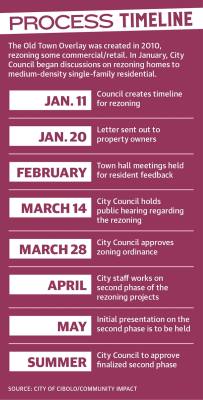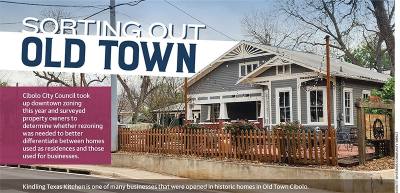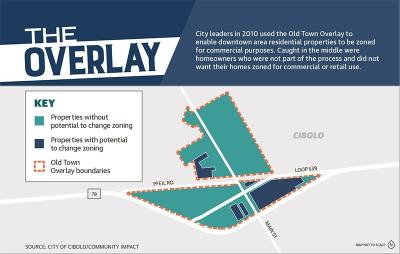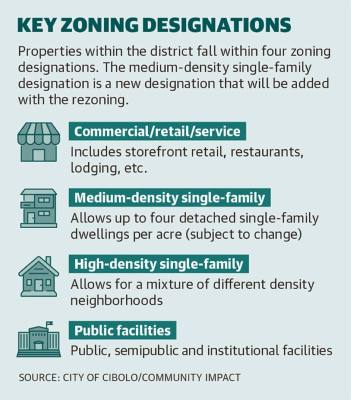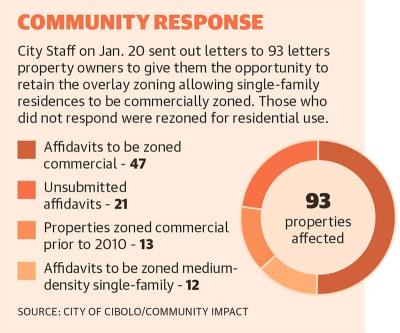Cibolo City Council members voted March 28 to approve rezoning some areas within Old Town Cibolo, a measure meant to clarify zoning that had left some residents frustrated because changes made in 2010 resulted in their homes being designated as commercial properties.
The controversy of Old Town’s zoning, and more specifically Main Street, began in 2010, when Cibolo City Council took up discussion of a long-range strategic plan called the Downtown Revitalization Plan that ultimately led to a vote to add additional zoning to parts of Old Town using what is called an overlay district, according to city staff.
An overlay adds another layer of zoning on top of the existing zoning designations, which allows any property within the overlay, even residential, to operate as a commercial business.
The main goal of the overlay district was to use the zoning to encourage more businesses to open in Old Town, thereby promoting growth in the area while at the same time maintaining Old Town’s historic appeal.
In some respects, the overlay district did its intended job drawing in businesses to set up shop in some of the area’s historic homes, but one side effect of the overlay district—developers and business owners constantly trying to buy those properties—has left residents who want to stay in their homes frustrated and with no recourse.
Property owners have reported feeling unwelcome in their own neighborhoods and have taken their concerns to City Council, citing the 2010 rezoning changes were made without their participation or even notification.
District 4 Council Member Katie Cunningham said residents have told her they want the overlay zoning removed.
“I was the one who brought up the rezoning [in January],” Cunningham said. “That was because we received numerous complaints from residents who felt like they were being harassed by developers and businesses that wanted to buy their properties.”
The process
On Dec. 13, Cibolo City Council directed staff to give a presentation on how council could amend or remove the overlay district, and on Jan. 10, council members held the first discussion on rezoning residential properties in the district from commercial/retail to medium-density single-family residential.
Cunningham said the district—which falls within council districts 2 and 7—was created to align with the Downtown Revitalization Plan, which was approved in 2014 and implemented but not followed properly.
The Downtown Revitalization Plan was created to attract businesses and other amenities to the downtown area, which would have fallen under the commercial overlay zoning.
Cunningham said the district was created, but the city failed to use the revitalization plan, which led to an overlay that did not work for the area.
“Because [the plan] went on a shelf and wasn’t utilized, the Old Town Overlay didn’t make sense,” Cunningham said. “The overlay and the Downtown Revitalization Plan were thought of together.”
City Manager Wayne Reed said the process to rezone those residential properties consists of two steps. The first step is to rezone properties from commercial to medium-density single-family residential.
The second step, Reed said, is to create a new definition for medium-density single-family residential, or an exception for Old Town Cibolo where residential properties do not meet the requirements of the existing medium-density single-family residential zoning.
Planning and Zoning Commissioner Terry Hinze said the overlay zoning of commercial/retail, allows for commercially zoned properties to also be used as residential properties, which is not allowed for commercial zoning in other parts of the city.
At the March 8 Cibolo Planning and Zoning Commission meeting, Hinze recommended denying the rezoning, because he said it was unnecessary.
“The current Old Town Overlay zoning properly addresses all needs in the Old Town Cibolo District,” Hinze said.
With a planning and zoning commission vote of 5-1 to deny the rezoning, the item went to City Council on March 28, where it was approved in a 4-1 vote.
District 2 Council Member Randy Roberts voted against it, and District 7 Council Member Joel Hicks recused himself because he lives in the area.
Community concerns
Public hearings were held during City Council as well as planning and zoning meetings in February so community members could voice their concerns.
Also, property owners were mailed letters on Jan. 20, informing them of an option to opt out of the rezoning to medium-density single-family residential.
Of the 93 properties that fell within the rezoning area, 12 submitted affidavits to be rezoned as medium-density single-family residential, while 47 submitted affidavits to remain commercial/retail properties, and 21 did not respond. The remaining 13 properties were already zoned commercial/retail before 2010.
Local business owner Cassandra Kearns told council members the rezoning of properties would be a set back to business development in the area.
“If [City Council rezones], you are going to set back our downtown area for probably five-plus years while you sit here and figure out what you want it to look like and as you spend time to redo the plan,” she said.
Lamar Street resident Adam Savoy said he believes residents should have a choice in zoning, and the rezoning is welcome as long as residents agree.
“I think that the right thing for the city of Cibolo to do is to allow folks that want to stay commercial now to stay commercial and for those folks who want to revert back to what they were in 2010 to do that,” Savoy said.
Some residents expressed concerns with zoning changes affecting properties’ appraisal values.
Peter Snaddon, chief appraiser for the Guadalupe County Appraisal District, said protections are provided by the state to homeowners within an area where the zoning conflicts with the properties’ use.
The Texas Tax Code states the market value of a residence homestead shall be determined solely on the basis of the property’s value as a residence homestead, regardless of whether the residential use of the property by the owner is considered to be the highest
value and best use of the property.
This means resident homestead properties within the district should be appraised as residential regardless of the overlay zoning. “If the single-family residence is an owner’s elected homestead, a jurisdictional exception is afforded appraisal districts in the appraisal of the property,” Snaddon said.
The outcome
With the approval of the ordinance to rezone properties, city staff will begin work on the second phase of the project, which includes redefining the medium-density single-family residential zoning designation so it also applies to the Old Town Cibolo area. The remaining parts of the process are to be completed by the end of May, and until then, city officials will analyze the properties within the district and have staff return with an Overlay District Regulation, Reed said.
While the city has zoning for medium-density single-family areas, the properties that fall within the district will follow an alternative definition, similar to how commercial zoning varies between downtown and the rest of the city.
Now, property owners who wish to sell to developers or start a business will have to go through the rezoning process again, Reed said.
“[The rezoning] gives the property owners assurance that their property can remain a single-family [residence] without commercial uses,” Reed said.





